AUDI A3 CABRIOLET 2015 Owners Manual
Manufacturer: AUDI, Model Year: 2015, Model line: A3 CABRIOLET, Model: AUDI A3 CABRIOLET 2015Pages: 302, PDF Size: 73.83 MB
Page 131 of 302
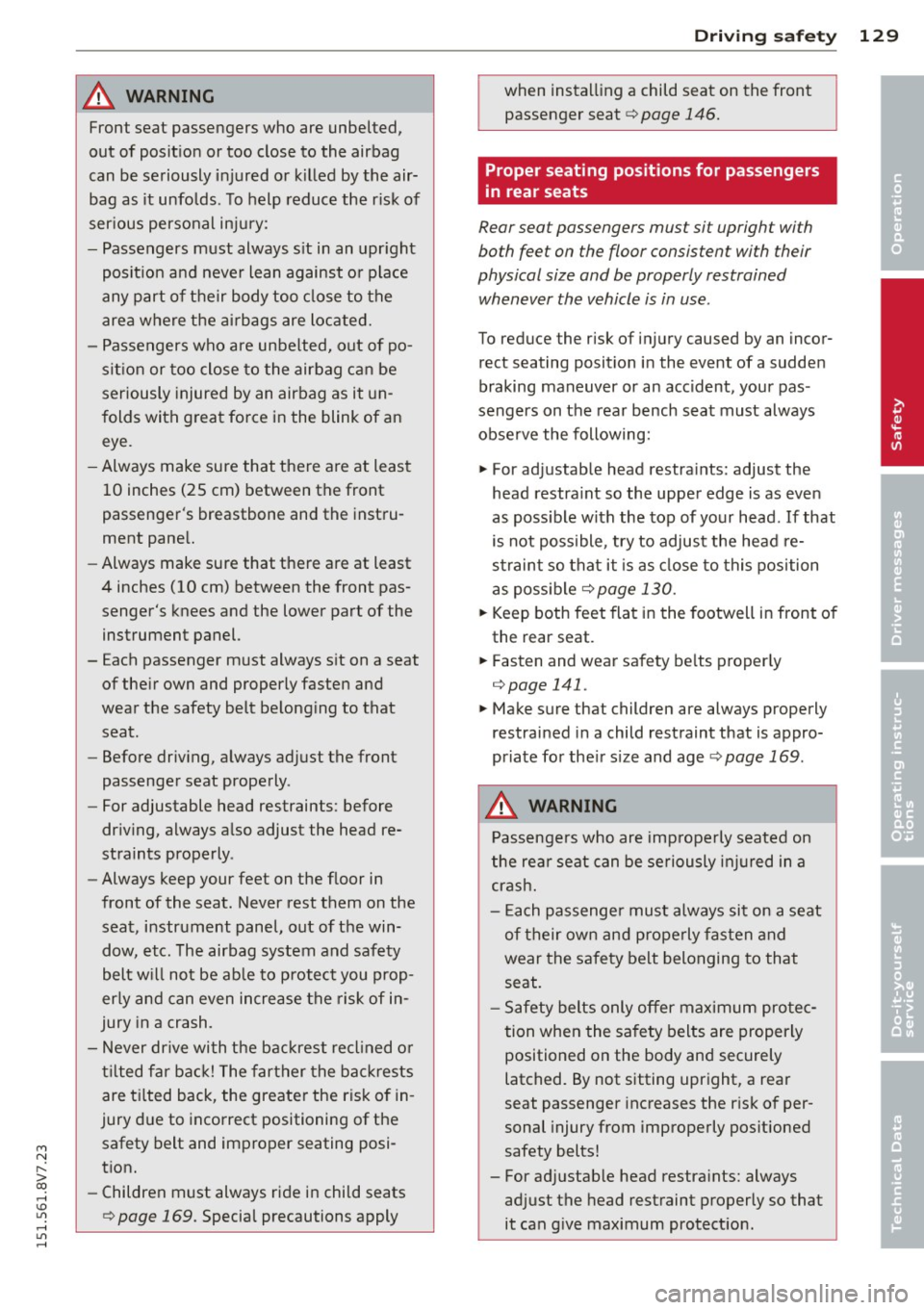
M N
" > co ,...., \!) 1.1'1 ,...., 1.1'1 ,....,
A WARNING ,~ ~
Front seat passengers who are unbelted,
out of posit ion or too close to the airbag
can be seriously injured or k illed by the air
bag as it unfolds. To help reduce the r isk of
ser ious personal inju ry:
- Passengers must always s it in an upr ight
posit ion and never lean against o r place
any part of their body too close to the
area where the airbags are located.
- Passengers who are unbelted, out of po
sit ion or too close to the airbag can be
seriously injured by an airbag as it un
f olds with great force in the blink of an
eye.
- Always make sure that there are at leas t
10 inches (25 cm) between the front
passenger's breastbone and the instru
ment pane l.
- Always make sure that there are at least
4 inches (10 cm) between the front pas
senger's knees and the lower part of the
instrument panel.
- Each passenger m ust always s it on a seat
of the ir own and properly fasten and
wea r the safety belt be long ing to that
seat .
- Before driv ing, a lways adjust the front
passenger seat properly .
- For adjustable head restraints : before
dr iv ing, always a lso adjust the head re
straints properly .
- Always keep your feet on the f loor in
front of the seat . Never rest them on the
seat, instrument panel, out of the win
dow, etc. The airbag system and safety
belt w ill not be ab le to protec t you prop
e rl y and can even incre ase the ris k of in
jury in a crash .
- Never drive wi th the backrest recl ined o r
t il ted far bac k! T he farther the backrests
are t ilted back , the greater the ris k of in
jury d ue to incorrect positioning of the
safety belt and improper seating posi
t ion.
- Children must always ride in child seats
¢
page 169. Special precautions apply
Dri ving s afe ty 129
when instal ling a child seat on the front
passenger seat¢
page 146.
Proper seating positions for passengers
in rear seats
Rear sea t passengers mus t sit uprigh t wi th
both fee t on the floor consistent wi th their
physical size and be properly restrained whenever the vehicle is in use .
To reduce the risk of injury caused by an incor
rect seating posit ion in the event of a sudde n
braking maneuver or an accident, your pas
sengers on the rear bench sea t must always
obse rve the following:
... For ad justab le head restra ints: adjust the
head restra int so the uppe r edge is as even
as poss ible with the top of your head . If that
is not poss ible, try to adjus t the head re
s tr aint so that it is as close to this position
as poss ible
¢ page 130 .
... Keep both feet flat in the footwell in front of
the rear seat .
... Fasten and wea r safety be lts proper ly
¢ page 141 .
... Make sure that children are always properly
restrained in a child restraint that is appro
pr iate for the ir size and age
¢ page 169.
A WARNING
Passengers w ho are imp roperly seated on
the rea r seat can be se rio usly in jured in a
cr ash.
- Each passenge r must always si t on a seat
of their own and properly fa sten and
wear the safe ty belt belonging to that
seat.
- Safety belts only o ffer maximum pro tec
tion when the sa fety belts are properly
positioned on the body and securely
latched. By not sitting upr ight, a rear
seat passenger increases the r is k of per
sonal injury from imp roperly pos itioned
safety belts!
- For ad justab le head restra ints: always
ad just the head restraint properly so that
it can g ive maximum protect ion .
•
•
•
Page 132 of 302
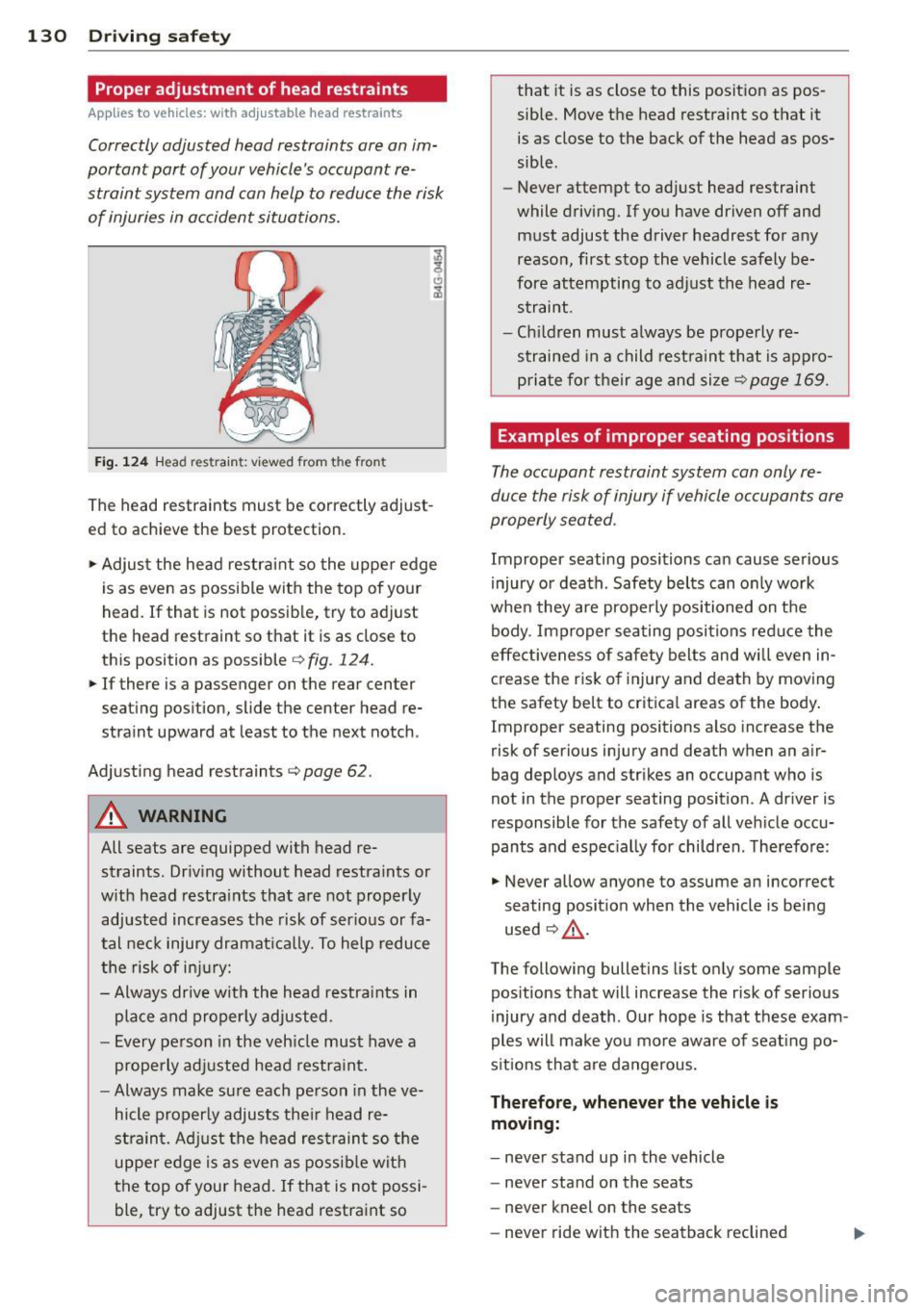
130 Driving safety
Proper adjustment of head restraints
App lies to vehicles: with adj ustable head restraints
Correctly adjusted head restraints ore on im
portant port of your vehicle's occupant re
straint system and con help to reduce the risk of injuries in occident situations.
Fig. 124 H ead re str ain t: vi ew ed fro m the front
The head restraints must be correctly adjust
ed to achieve the best protection .
.. Adjust the head restr aint so the upper edge
is as even as possible with the top of your
head. If that is not possible, try to adjust
the head restraint so that it is as close to
this position as possible
c:> fig . 124.
.. If there is a passenger on the rear center
seating position, slide the center head re
stra int upward at least to the next notch .
Ad justing head restraints
c:> page 62.
A WARNING
All seats are equipped with head re
straints. Dr iving without head restraints or
with head restraints that are not properly
adjusted increases the risk of serious or fa
t al neck injury dramat ically. To help reduce
the risk of injury:
- Always drive with the head restra ints in
place and properly adjusted.
- Every person in the veh icle must have a
properly adjusted head restra int.
- Always make sure each person in the ve
hicle properly adjusts the ir head re
straint. Adjust the head restraint so the
upper edge is as even as possible wit h
the top of your head.
If that is not possi
ble, try to adjust the head restra int so that
it is as close to this posit ion as pos
sible. Move the head restraint so that it
is as close to the back of the head as pos
sible .
- Never attempt to adjust head restraint
while driving. If you have driven off and
must adjust the driver headrest for any reason, first stop the vehicle safely be
fore attempting to adjust the head re
straint .
- Ch ildren must always be prope rly re
strained in a child restraint that is appro
p ria te for their age and size
¢ page 169.
Examples of improper seating positions
The occupant restraint system con only re
duce the risk of injury if vehicle occupants ore
properly seated .
Improper seating positions can cause serious
injury or death. Safety belts can only work
when they are properly positioned on the body . Improper seating positions reduce the
effect iveness of safety belts and wi ll even in
crease the risk of injury and death by moving
the safety be lt to critica l areas of the body .
Imprope r seating positions a lso increase the
risk of serious injury and death when an air
bag deploys and strikes an occupant who is
not in the proper seating position . A dr iver is
responsible for the safety of all veh icle occu
pants and espec ially for children . T herefore :
.. Never allow anyone to assume an incorrect
seating position when the vehicle is being
used
c:> . &.
The following bulletins list only some sample
pos itions that will increase the risk of serious
injury and death . Our hope is that these exam
ples will make you more aware of seat ing po
s itions that are dangerous.
Therefore, whenever the vehicle is
moving:
- never stand up in the vehicle
- never stand on the seats
- never kneel on the seats
- never ride with the seatback reclined
Page 133 of 302
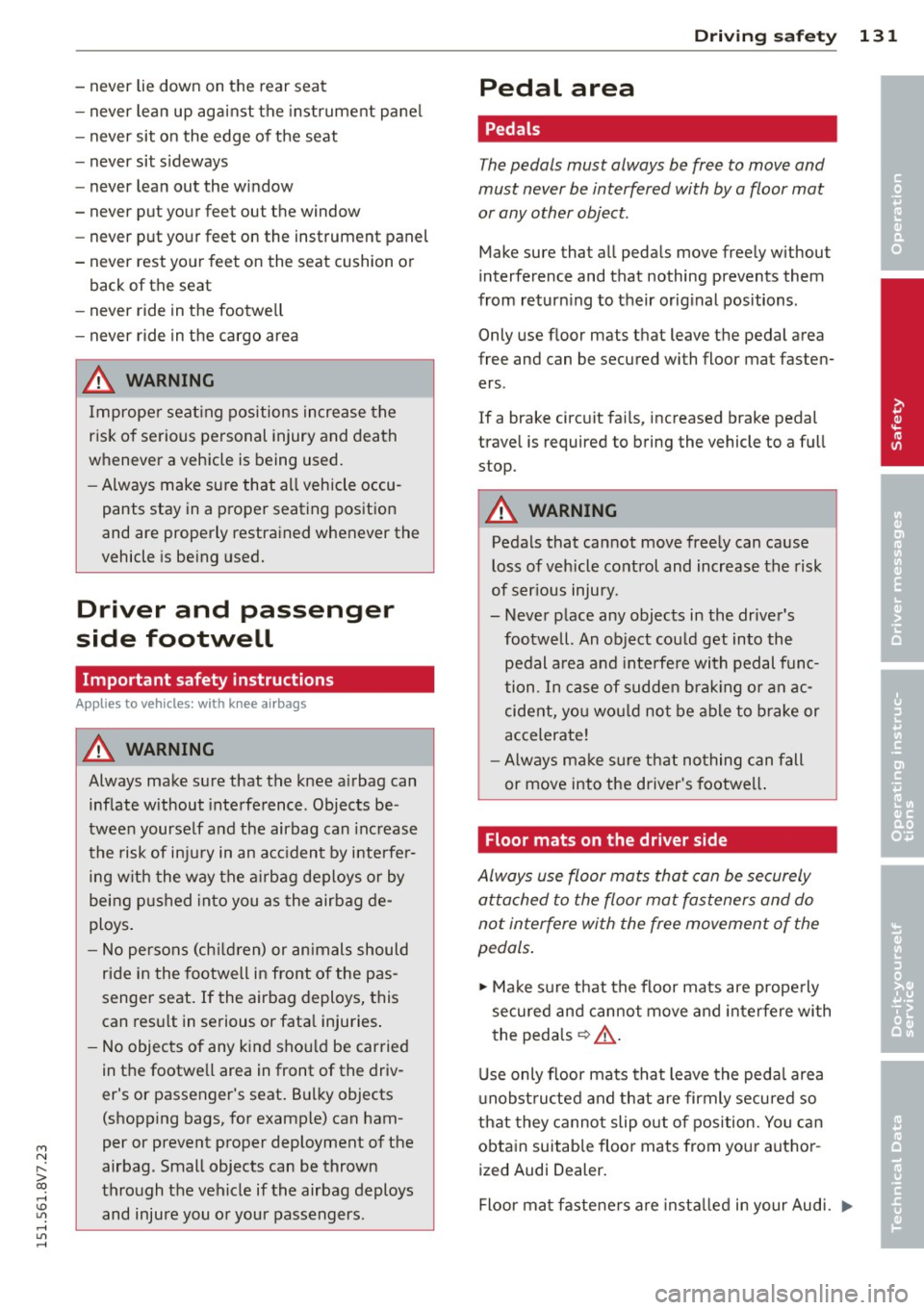
M N
" > co ,...., \!) ..,.,
,...., ..,., ,....,
-never lie down on the rear seat
- never lean up against the instrument pane l
- never sit on the edge of the seat
- never sit s ideways
- never lean out the w indow
- never put your feet out the window
- never put your feet on the instrument panel
- never rest your feet on the seat cushion or
back of the seat
- never ride in the footwell
- never ride in the cargo area
A WARNING
Imprope r seat ing positions increase the
risk of serious personal injury and death
whenever a vehicle is being used.
- Always make sure that all vehicle occu
pants stay in a proper seating position
and are properly restra ined whenever the
vehicle is being used.
Driver and passenger
side footwell
Important safety instructions
Applies to vehicles: with knee airbags
A WARNING
Always make sure that the knee airbag can
inflate without interference . Objects be
tween yourself and the airbag can increase
the risk of inju ry in an acc ident by interfer
ing w ith the way the a irbag deploys or by
being p ushed into you as the airbag de
ploys .
- No persons (ch ild ren) or animals should
ride in the footwell in front of the pas
senger seat. If the airbag deploys, this
can res ult in serious or fata l injuries .
- No objects of any k ind sho uld be carried
in the footwe ll area in front of the driv
er's or passenger's seat . Bulky objects
(shopping bags, for example) can ham
per or prevent proper deployment of the
airbag . Small objects can be thrown
through the vehicle if the airbag deploys and injure you or your passengers .
-
Driving s afe ty 131
Pedal area
Pedals
The pedals must always be free to move and
must never be interfered with by a floor mat
or any other object.
Make sure that a ll peda ls move free ly without
interfe rence and that nothing prevents them
from return ing to their orig inal positions .
Only use floor mats that leave the pedal area
free and can be secured with floor mat fasten ers .
If a brake circ uit fai ls, increased brake pedal
trave l is required to bring the vehicle to a fu ll
stop.
A WARNING
Pedals that cannot move free ly can cause
loss of vehicle control and increase the risk
of ser ious injury.
- Never p lace any objects in the driver's
footwell. An object cou ld get into the
pedal area and inte rfere with pedal func
tion. In case of sudde n brak ing o r an ac
cident, yo u wo uld not be able to brake or
accelerate!
- Always ma ke s ure that no thing can fall
or move into the driver's footwel l.
Floor mats on the driver side
Always use floor mats that can be securely
attached to the floor mat fasteners and do
not interfere with the free movement of the
pedals.
"' Ma ke sure t hat the floor mats are prope rly
secured and cannot move and in terfere with
t he peda ls ¢ ..&_ .
Use only floor mats that leave the peda l area
u nobst ructed and th at are firmly secu red so
that they c annot slip o ut of position. You c an
obtain suitab le floor mats from you r autho r
ized Audi Dealer.
Floor mat fastene rs a re insta lled in your Aud i.
1111>
•
•
•
Page 134 of 302
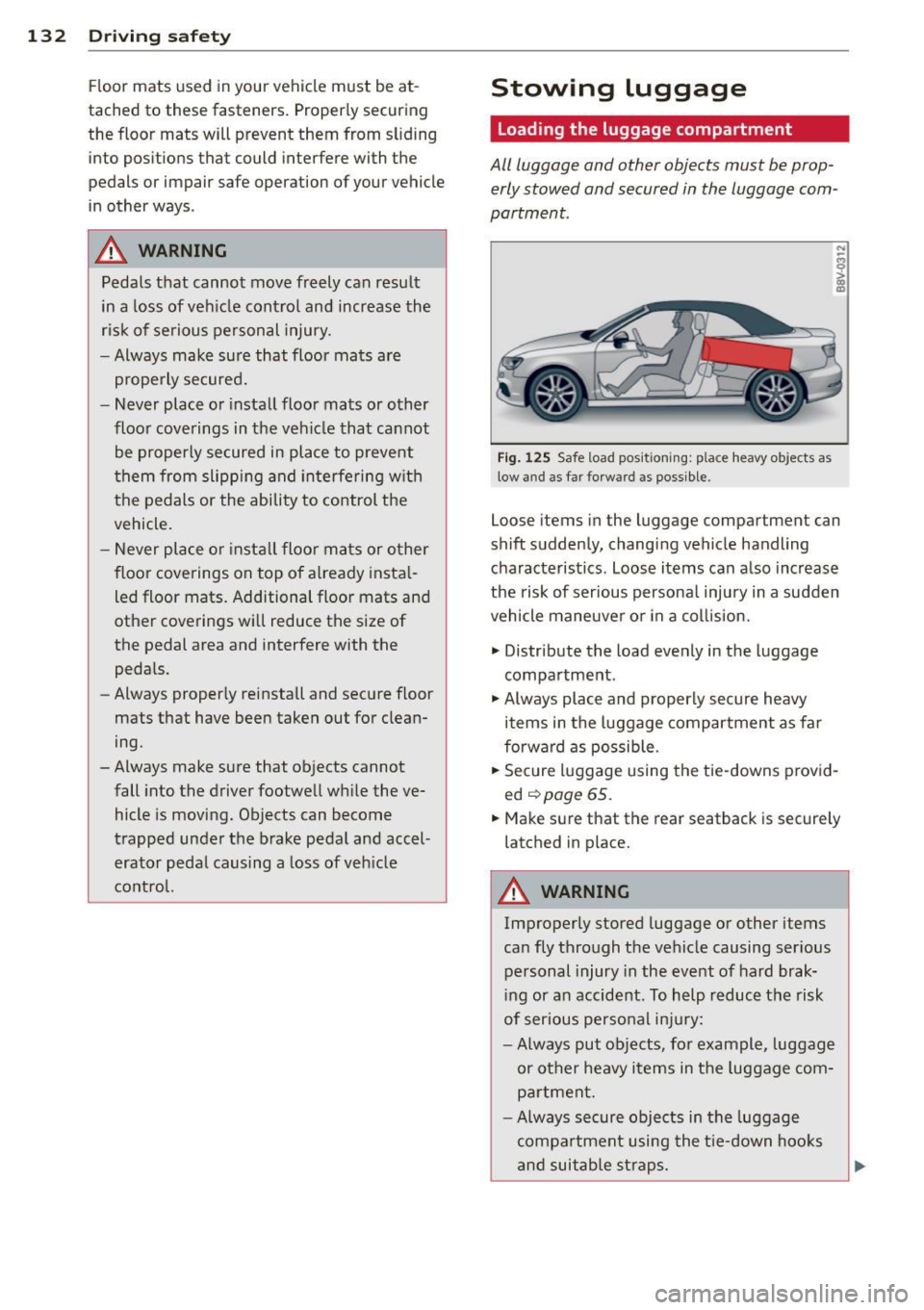
132 Driving safety
Fl oor mats used in your vehicle must be at
tached to these fasteners. Properly securing
the floor mats will prevent them from sliding into positions that could interfere with the
pedals or impair safe operation of your vehicle
in other ways .
A WARNING
Pedals that cannot move freely can result
in a loss of vehicle contro l and increase the
r isk of serious personal injury.
- Always make sure that floor mats are
properly secured.
- Never place or install floor mats or other
floor coverings in the vehicle that cannot
be properly secured in place to prevent
them from slipping and interfering with
the pedals or the ability to control the
vehicle.
- Never place or insta ll floor mats or other
floor coverings on top of a lready instal
led floor mats. Additional floor mats and
other coverings will reduce the s ize of
the pedal area and interfere with the pedals.
- Always properly reinstall and secure floor
mats that have been taken out for clean
ing.
- Always make sure that objects cannot
fall into the driver footwell wh ile the ve
hicle is moving. Objects can become
trapped under the brake pedal and accel erator pedal causing a loss of veh icle
control.
Stowing luggage
Loading the luggage compartment
All luggage and other objects must be prop
erly stowed and secured in the luggage com
partment.
Fig. 125 Safe load positio nin g: place heavy objects as
low and as far forwa rd as possible .
N
-..,
~ C0 m
Loose items in the luggage compartment can
shift suddenly, changing vehicle handling
characteristics. Loose items can also increase
the risk of serious persona l injury in a sudden
vehicle maneuver or in a collis ion.
.,. Distribute the load evenly in the luggage
compartment.
.,. Always place and properly secure heavy
items in the luggage compartment as far
forward as possible.
.,. Secure luggage using the tie-downs prov id
ed
.::,page 65.
.,. Make sure that the rear seatback is securely
latched in place.
A WARNING
-Improperly stored luggage or other items
can fly through the vehicle causing ser ious
personal injury in the event of hard brak
i ng or an accident. To help reduce the risk
of ser ious personal inju ry:
- Always put objects, fo r example, luggage
or other heavy items in the luggage com
partment.
- Always secure objects in the luggage
compartment using the tie-down hooks
and suitable straps.
Page 135 of 302
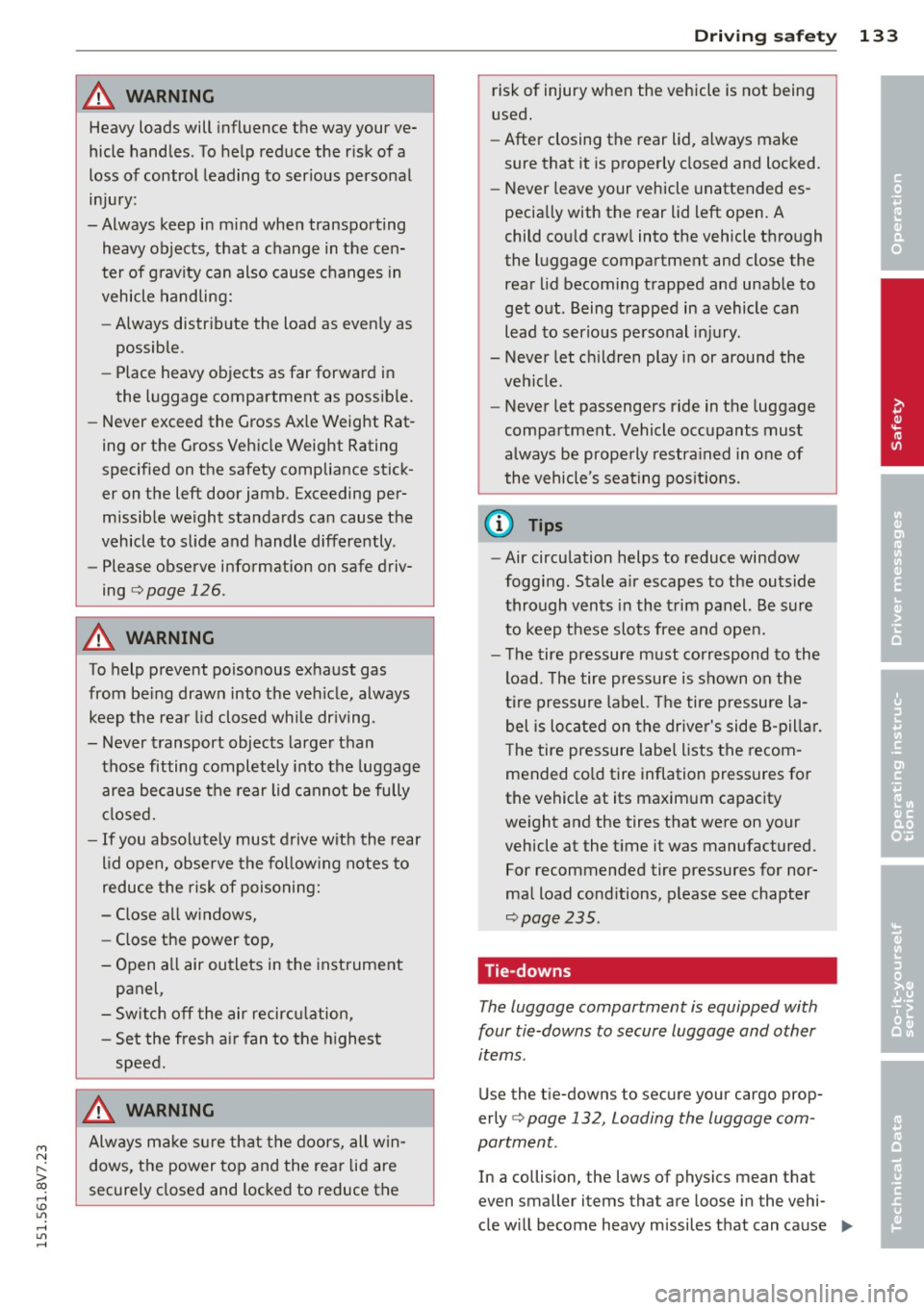
M N
" > co ,...., \!) 1.1'1 ,...., 1.1'1 ,....,
A WARNING ,~
Heavy loads will influence the way your ve
hicle handles. To help reduce the r isk of a
loss of control leading to ser ious personal
injury:
-Always keep in m ind when transporting
heavy objects, that a change in the cen
ter of gravity can also cause changes in
vehicle handling:
- Always distr ibute the load as even ly as
possible.
- Place heavy objects as far forward in
the luggage compartment as poss ible.
- Never exceed the Gross Ax le Weight Rat
ing or the Gross Vehicle Weight Rating
specified on the safety compliance stick
er on the left do or jamb. Exceeding per
missib le we ight standards can cause the
vehicle to s lide and handle differently.
- Please observe information on safe driv
ing co
page 126.
A WARNING
To help prevent poisonous exhaust gas
from be ing drawn into the veh icle, always
keep the rea r lid closed while dr iving.
- Never transport objects larger than those fitting completely into the luggage
area because the rear lid cannot be fully
cl osed.
- If you absolutely must drive w ith the rear
l id ope n, observe the follow ing notes to
reduce the risk of poisoning:
- Close all windows,
- Close the power top,
- Open all air ou tlets in the instrument
panel,
- Sw itch off the air recircu lation,
- Set the fresh ai r fan to the h ighest
speed.
A WARNING
Alw ays m ake s ure th at the doors, all win
dows, the power top an d the re ar lid are
securely closed and locked to reduce th e
Dri ving s afe ty 133
risk of injury when the vehicle is not being
used .
- After closing the rear lid, always make
sure that it is properly closed and loc ked.
- Never leave your vehicle unattended es
pecially with the rear lid left open. A
child cou ld craw l into the vehicle thro ugh
the luggage compartment and close the
rea r lid becoming t rapped and unable to
get out. Being trapped in a vehicle can
lead to serious pe rsonal inj ury.
- Never let ch ildren play in or around the
veh icle.
- Never let passengers ride in the luggage
compa rtment. Vehicle occupants must
always be properly restra ined in one of
the vehicle's seating pos it ions.
(D Tips
- Air circulati on helps to reduce window
fogging . S tale a ir escapes to the outside
through ven ts in the t rim panel. Be sure
t o keep these slots free an d ope n.
- T he tire pressure m ust correspond to the
load. The tire pressure is shown on the
t ire pressure label. T he tire pressure la
bel is located on the driver's side B-pilla r.
T he tire pressure label lists the recom
mended co ld tire inflation pressures fo r
the vehicle at its maxim um capacity
weight and the tires that were on your
vehicle at the time it was manufactured.
For recommended tire pressures f or nor
ma l load cond itions, p lease see chapter
co
page 235.
Tie-downs
The luggage compartment is equipped with
four tie-downs to secure luggage and other
items .
Use the t ie-downs to secure your cargo prop
erly co
page 132, Loading the luggage com
partment.
In a collision, the laws of physics mean th at
even smaller items that are loose in the vehi-
cle w ill become heavy m issiles that can cause .,.. •
•
Page 136 of 302
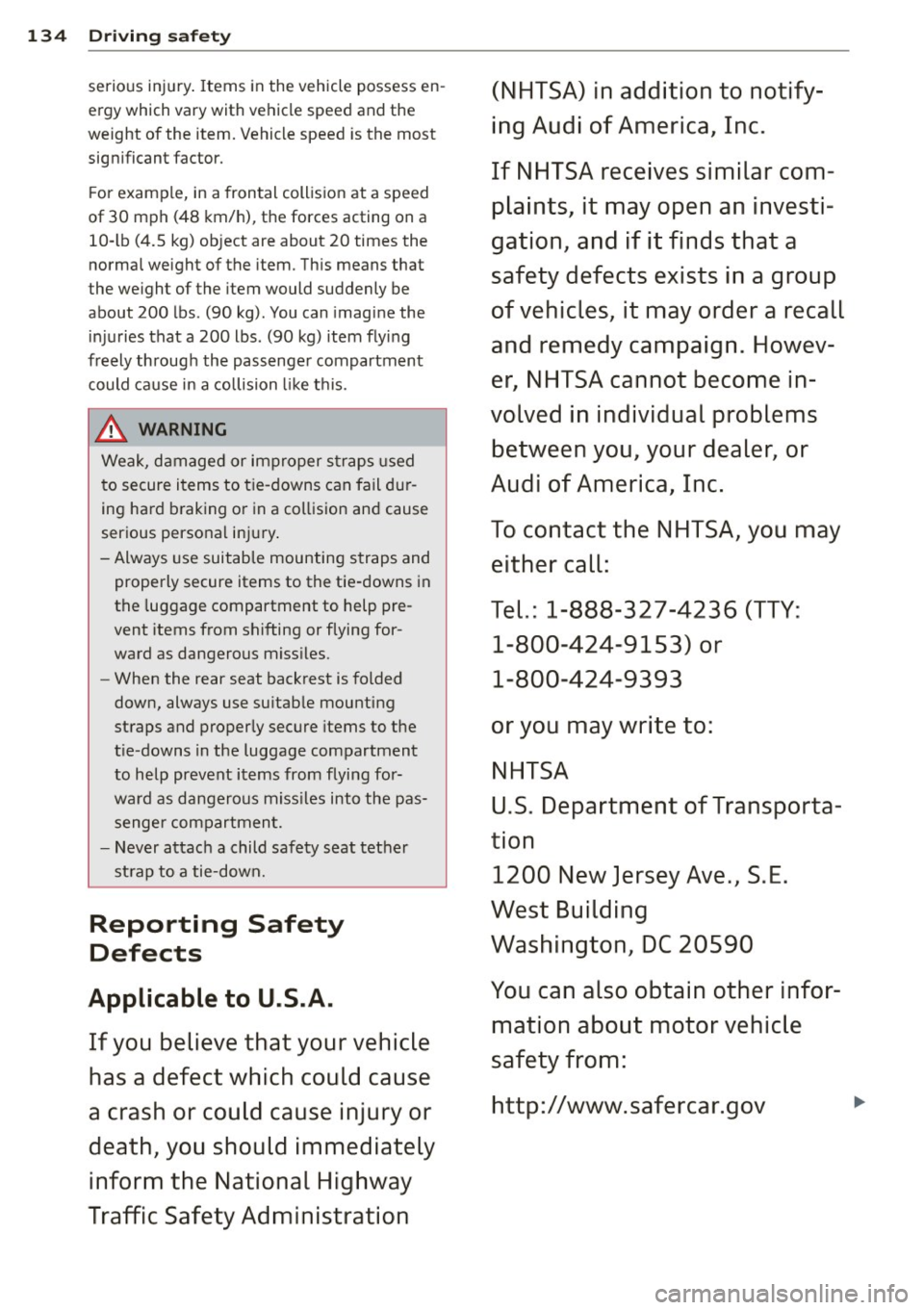
134 Driving saf ety
serious injury . Items in the vehicle possess en
ergy which vary with vehicle speed and the
weight of the item. Vehicle speed is the most
significant factor.
F or example, in a frontal collision at a speed
of 30 mph (48 km/h), the forces acting on a 10- lb (4.5 kg) object are about 20 times the
norma l weight of the item. Th is means that
the we ight of the item would suddenly be
about 200 lbs. (90 kg). You can imagine the
i njuries that a 200 lbs . (90 kg) item flying
freely through the passenger compartm ent
could cause in a collision like t his.
_& WARNING
Weak, damaged or improper straps used
to secure i tems to tie-downs can fail du r
ing hard braking or in a collision and cause
ser ious personal injury .
- Always use suitab le mounting straps and
properly secure items to the tie-downs in
the luggage compartment to help pre
vent items from shifting or flying for
ward as dangerous miss iles.
- When the rear seat backrest is folded
down, always use su itab le mounting
straps and properly secure items to the
t ie-downs in the luggage compartment
to help prevent items from flying for
ward as dangerous miss iles into the pas
senger compartment.
- Never attach a child safety seat tether
strap to a tie-down.
Reporting Safety
Defects
Applicable to U.S.A.
If y ou beli eve that your vehi cle
h as a def ect whi ch could cause
a cra sh or could cau se injur y or
d eath, yo u should immediatel y
inform the N ati onal High way
Tr affic S afe ty Admini stration (
NHTSA) in addition to notif y
in g Audi of Am eric a, Inc .
If NHTSA r ecei ves similar com
plaints, it may open an inve sti
gation , and if it finds that a
s afety defect s ex is ts in a group
of vehicles , it may order a recall
and r emed y campaign . Howe v
er, NHTSA cannot become in
vol ved in indi vidual problems
bet ween you, your dealer , or
Audi of A merica, Inc.
To c onta ct the NHTSA, you ma y
e ither c all:
Tel.: 1-888-3 27-4236 (TTY :
1-800-424-9153) or
1-800-424-9393
or you ma y write to:
NHTSA
U .S . D epartm ent of Tr ansport a
tion 1200 New Jer sey A ve ., S . E .
W est Building
W ashin gton , D C 20590
You can al so obtain other infor
mation about motor vehicle
s afety from:
h ttp: / /www .s af ercar.g ov
Page 137 of 302
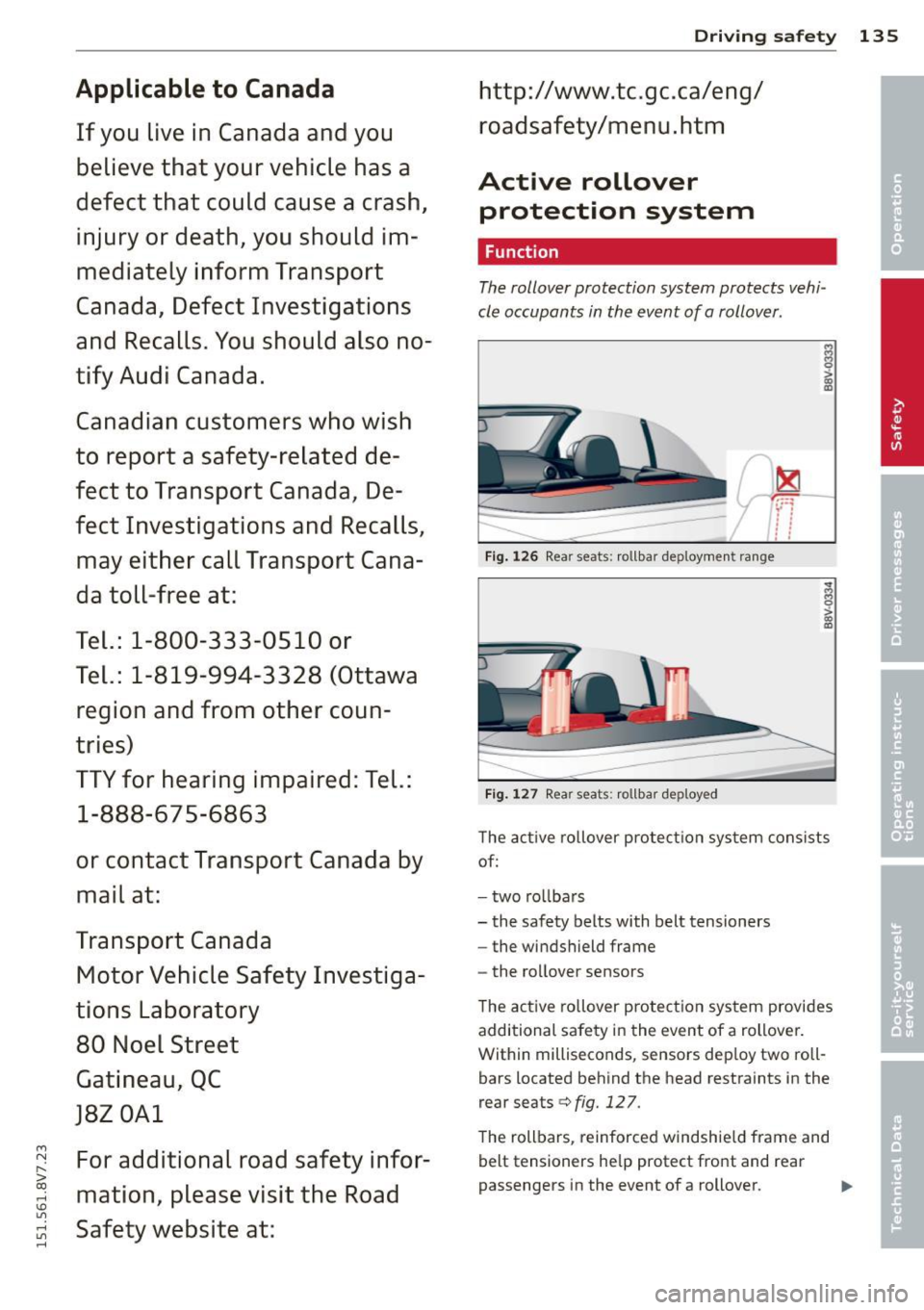
....,
N
r--. > co
rl I.O
"' rl
"' rl
Applicable to Canada
If you live in Canada and you
believe that your vehicle has a
defect that could cause a crash,
injury or death, you should im
mediately inform Transport
Canada, Defect Investigations
and Recalls. You should also no
tify Audi Canada.
Canadian customers who wish
to report a safety-related de
fect to Transport Canada , De
fect Investigations and Recalls,
may either call Transport Cana
da toll-free at:
Tel.: 1-800-333-0510 or
Tel.: 1-819-994-3328 (Ottawa region and from other coun
tries)
TTY for hearing impaired : Tel.:
1-888-675-6863
or contact Transport Canada by
mail at:
Transport Canada Motor Vehicle Safety Investiga
tions Laboratory
80 Noel Street
Gatineau, QC
J8Z 0Al
For additional road safety infor
mation, please visit the Road
Safety website at :
Driving safety 135
http://www.tc.gc.ca/eng/
roadsafety/menu. htm
Active rollover
protection system
. Function
Th e rollov er p rotection syst em prot ects v ehi
cl e o ccupants in th e ev ent of a ro llove r.
Fig. 126 Rear seats: roll ba r dep loy ment range
Fig. 127 Rea r seats : rollba r deploye d
The acti ve rollo ver p rotection s yst em consist s
o f:
- t wo r oll bar s
- t he safe ty b elts with b elt tensioners
- the wi ndshield frame
- the ro llover sensors
T he acti ve ro llover p rotec tion sys tem provi des
addi tion al sa fe ty in t he event of a rollover .
Within milli seco nds, sensors dep loy two roll
bars located be hind t he head restraints in the
rear seats ¢
fig. 127.
The roll bars, reinforce d w indsh ie ld frame and
b elt tensioners he lp protect fro nt and rear
passengers in th e event of a r ollove r.
Page 138 of 302
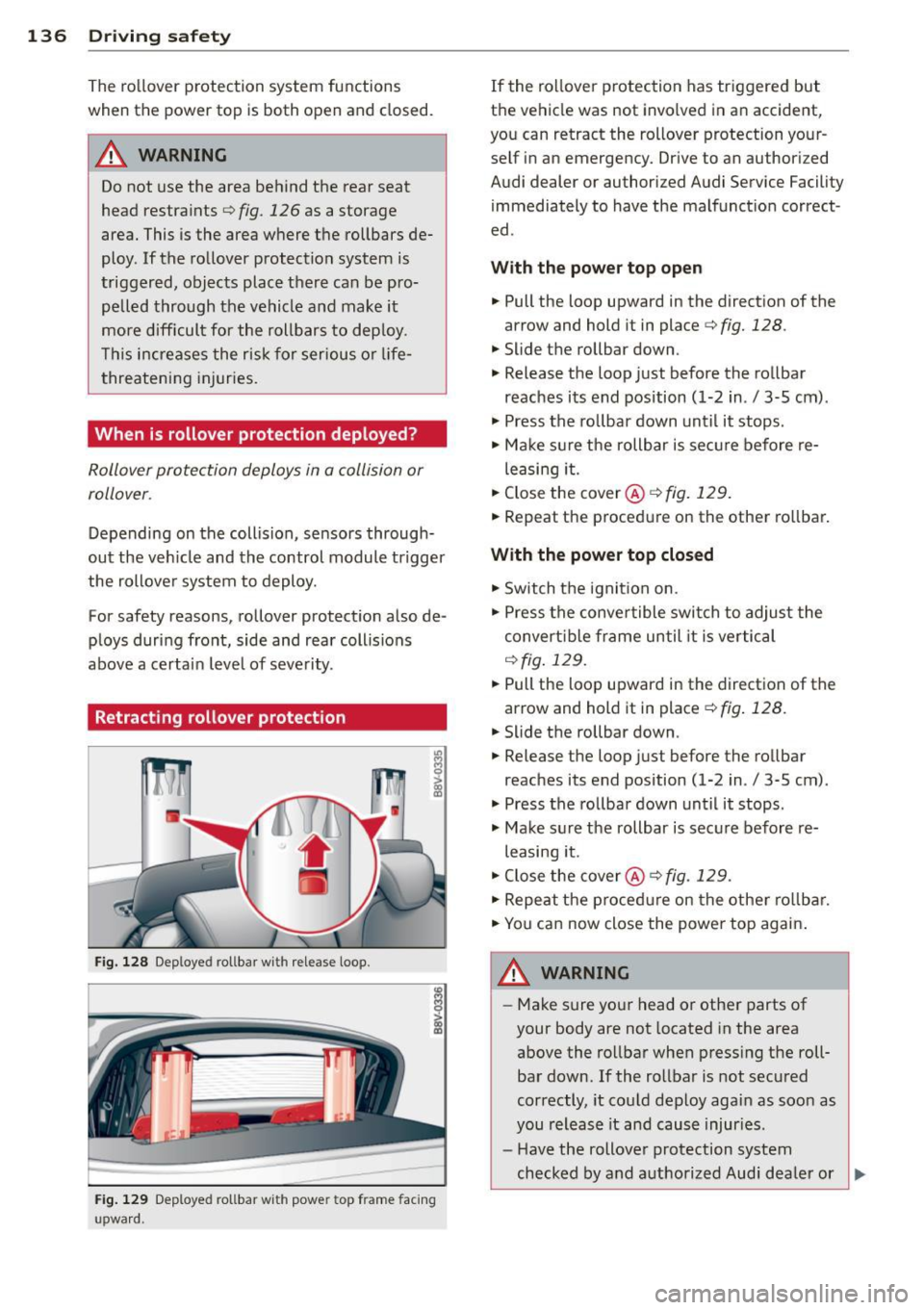
136 Driving safety
The ro llover protection system functions
when th e power top is both open and closed .
.&_ WARNING
Do not use the area behind the rear seat
head restraints
q fig. 126 as a storage
area. This is the area where the rollbars de
ploy . If the rollover protection system is
triggered, objects plac e there can be p ro
pell ed through the vehicle and make it
more diff icul t for the rollbars to dep loy.
T his i ncreases the risk for serious o r life
threatening injuries.
When is rollover protection deployed?
Rollover protection deploys in a collision or
rollover.
Depending on the collision, se nsors through
out the ve hicle and the control module tr igger
the rollove r system to deploy.
For safety reasons, rollover protect ion also de
p loys duri ng front, side and rear collisions
above a certa in leve l of seve rity .
Retracting rollover protection
Fig. 128 Deployed ro llba r wit h release loop .
Fig. 129 Dep loye d rollbar w it h powe r top frame fac ing
up wa rd .
If the rollover p rotection has tr iggered but
t h e vehicle was not invo lved in an accident,
you can retract the rollover protection your se lf in an emergency. Dr ive to an author iz ed
Audi dealer or authorized Audi Service Facility immediately to have the malfunct ion correct
ed .
With the power top open
.. Pull the loop upward in the direct ion of the
arrow and hold it in place Q
fig. 128.
.. Slide the rollbar down .
.,. Release the loop just before the ro llbar
reaches its end position (1-2 in ./ 3-5 cm) .
.,. Press the ro llbar down un til it stops .
.,. Ma ke s ure the rollbar is se cure before re-
leasing it.
.,. Close the cover@Q
fig. 129.
.. Repeat the p roced ure on the other ro llbar .
With the power top closed
.,. Switch the ignit ion on .
.,. Press the conve rtible swit ch to adjust the
convert ible frame until it is ve rtical
q fig .129.
.. Pull the loop upward in the direct ion of the
arrow and hold it in place ¢
fig. 128.
.. Slide the rollbar down .
.. Release the loop just before the rollbar
reaches its end position (1-2 in ./ 3-5 cm) .
.,. Press the rollbar down un til it stops .
.,. Ma ke s ure the rollbar is sec ure befor e re-
leasing it .
.,. Close the cover @¢
fig. 129 .
.. Repeat the p roced ure on the othe r rollb ar .
.. Yo u can now close the powe r top again .
_& WARNING
-
-Make sure you r head or othe r parts of
your body are not located in the area
above the ro llbar when press ing the roll
bar down. If the rollbar is not secured
correctly, it cou ld deploy again as soon as
you releas e it an d cause injur ies.
- Have the rollover protection system
checked by and a uthorized Audi dea ler or ..,.
Page 139 of 302
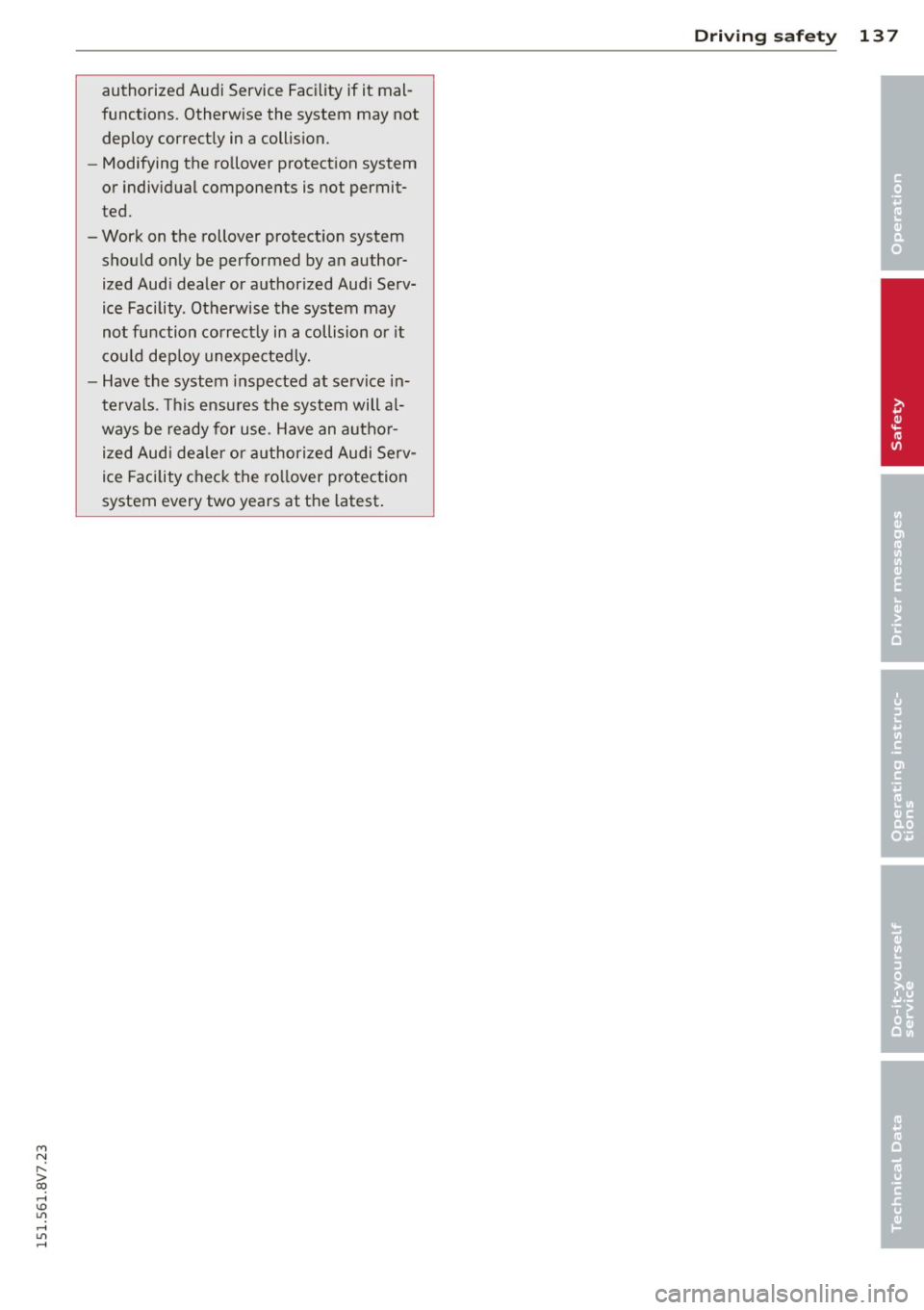
M N
" > co ,...., \!) 1.1"1 ,...., 1.1"1 ,....,
authorized Audi Service Facility if it mal
functions. Otherw ise the system may not
deploy correct ly in a collision.
- Modifying the ro llover protection system
or individual components is not permit
ted.
- Work on the rollover protect ion system
should only be performed by an author
ized Audi dealer or authorized Audi Serv
ice Facility. Otherwise the system may
not function correctly in a collision or it
cou ld dep loy unexpectedly.
- Have the system inspected at service in
tervals. This ensures the system will a l
ways be ready for use . Have an autho r
ized Audi de aler or authorized Audi Serv
ice Facility check the ro llover p rotection
system every two years at the latest .
Driving s afe ty 137
•
•
•
Page 140 of 302
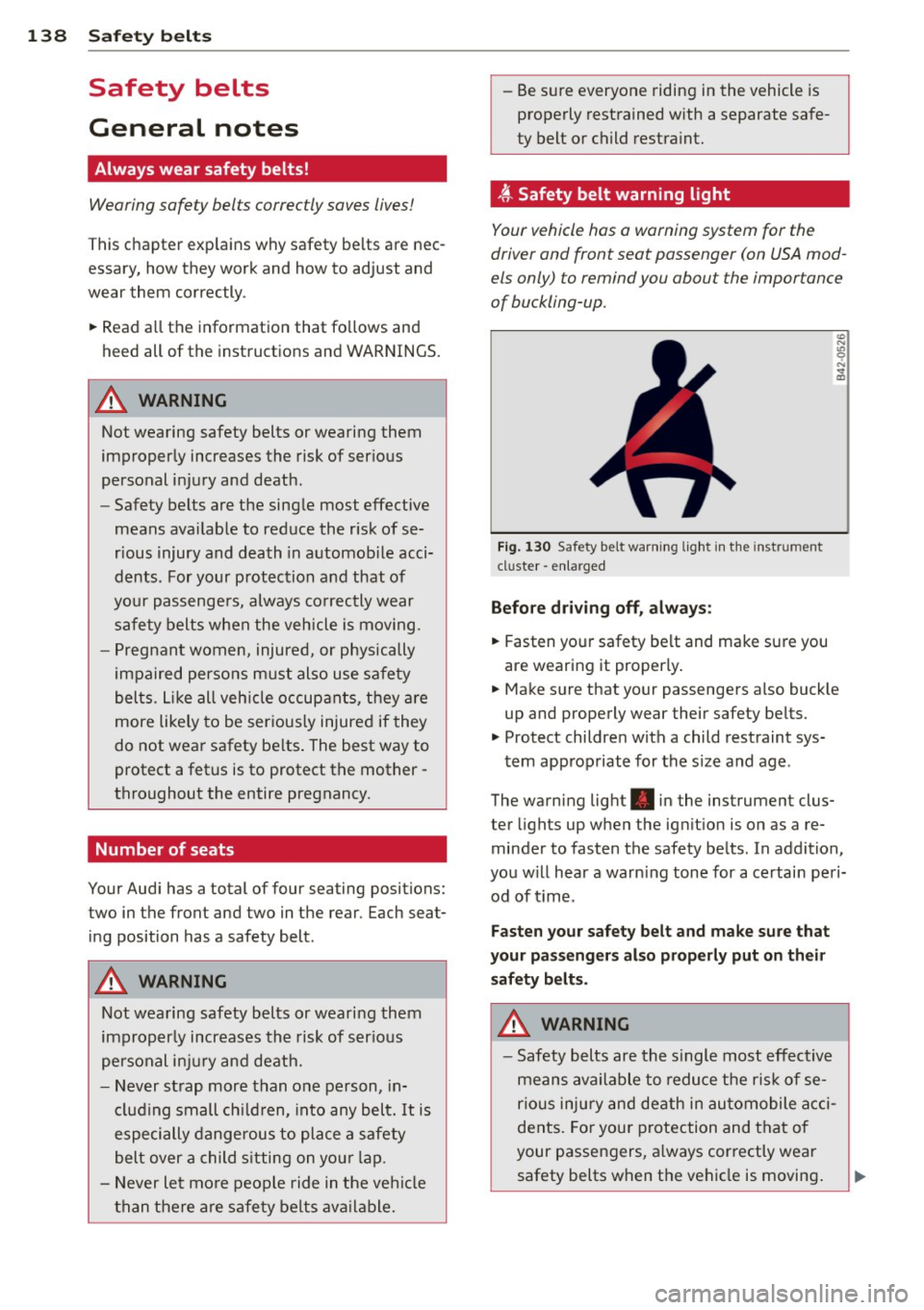
138 Safety belts
Safety belts
General notes
Always wear safety belts!
Wearing safety belts correctly saves lives!
This chapter explains why safety be lts are nec
essary, how they work and how to adjust and
wear them correctly .
.. Read a ll the information that fo llows and
heed all of the instructions and WARNINGS.
A WARNING
Not wearing safety belts or wearing them
improperly increases the risk of ser ious
personal in jury and death .
- Safety belts are the sing le most effective
means avai lab le to reduce the risk of se
r ious injury and dea th in a utomob ile acci
dents. For your protection and that of
yo ur passenge rs, always co rrectly wear
safety belts when the vehicle is moving.
- Pregnant women, injured, or physically
im paired perso ns m ust also use safety
belts. Lik e all veh icle occup ants, they are
more like ly to be ser iously injured if they
do not wea r safety be lts . The best way to
protect a fetus is to protect the mother -
throughout the entire pregnancy.
Number of seats
Your Audi has a total of four seating positions: two in the front and two in the rear. Each seat
ing position has a safety belt .
A WARNING
Not wearing safety belts or weari ng them
improp erly increases th e risk of ser ious
pe rsonal i njury and deat h.
- Never st rap more than one pe rson, in
cl uding small ch ild ren, into any belt.
It is
e speci ally dange rous to pla ce a safety
belt over a child s itting on yo ur lap.
- N ever le t mo re people ride in the ve hicl e
than there are s afe ty be lts avail able. -
Be s ure everyone riding in the vehicle is
properly restrained w ith a separate safe
ty belt or child restra int.
t Safety belt warning light
Your vehicle hos o warning system for the
driver and front seat passenger (on USA mod
els only) to remind you about the importance
of buckling-up .
Fi g. 130 Safety belt warni ng light in the instrument
cluster -en larged
Before driv ing off, alway s:
.. Fasten yo ur safety belt and make su re you
are wearing it properly .
.. Make s ure that your passengers also buck le
up and properly wear their safety be lts.
.. Protect childre n w ith a child restraint sys-
tem app ropriate for the s ize and age.
The warn ing light . in the instrument clus
ter lights up when the ign ition is on as a re
minder to fasten the safety be lts. In addition,
you w ill hear a warn ing tone for a ce rtai n pe ri
od of t ime.
Fasten you r safety belt and make sure that
your pass eng ers also properly put on the ir
s afety belt s.
A WARNING .....=-
-Safety b elts are the s ingle most eff ect ive
means avai lable to reduce t he ri sk of se
rio us inju ry and de ath in au tomobile a cci
dents. Fo r you r protection and that of
your passengers, a lways cor rectly wear
safety belts when t he vehicle is moving .